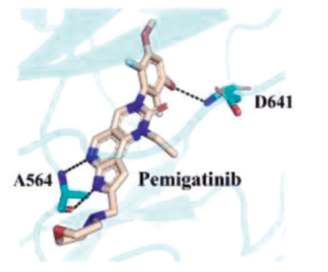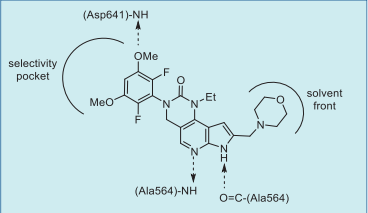| Identification | Back Directory | [Name]
Pemigatinib | [CAS]
1513857-77-6 | [Synonyms]
IBI-375
Pemigatinib
INCB-054828
3-(2,6-difluoro-3,5-dimethoxyphenyl)-1-ethyl-8-(morpholinomethyl)-1,3,4,7-tetrahydro-2H-pyrrolo[3',2':5,6]pyrido[4,3-d]pyrimidin-2-one
3-(2,6-difluoro-3,5-dimethoxyphenyl)-1-ethyl-8-(morpholin-4-ylmethyl)-1,3,4,7-tetrahydro-2H-pyrrolo[3',2':5,6]pyrido[4,3-d]pyrimidin-2-one
2H-Pyrrolo[3',2':5,6]pyrido[4,3-d]pyrimidin-2-one, 3-(2,6-difluoro-3,5-dimethoxyphenyl)-1-ethyl-1,3,4,7-tetrahydro-8-(4-morpholinylmethyl)- | [Molecular Formula]
C24H27F2N5O4 | [MDL Number]
MFCD31706227 | [MOL File]
1513857-77-6.mol | [Molecular Weight]
487.5 |
| Chemical Properties | Back Directory | [Boiling point ]
697.6±55.0 °C(Predicted) | [density ]
1.44±0.1 g/cm3(Predicted) | [storage temp. ]
Store at -20°C | [solubility ]
DMSO:40.0(Max Conc. mg/mL);82.05(Max Conc. mM) | [form ]
A crystalline solid | [pka]
11.56±0.40(Predicted) | [color ]
White to light yellow |
| Hazard Information | Back Directory | [Uses]
Pemigatinib is a potent inhibitor of FGFRs for the treatment of cholangiocarcinoma. | [Indications]
Pemigatinib is indicated for the treatment of previously treated adult patients with unresectable locally advanced or metastatic cholangiocarcinoma (CCA) who have been identified by an FDA-approved test for the presence of fibroblast growth factor receptor 2 (FGFR2) fusions or other rearrangements. | [Brand name]
Pemazyre | [General Description]
Class: receptor tyrosine kinase;
Treatment: metastatic cholangiocarcinoma;
Other name: INCB054828;
Elimination half-life = 15 h;
Protein binding = 90.6% | [target]
Primary targets: Pan-FGFR | [IC 50]
FGFR1/2/3/4 IC 50 = 0.4, 0.5, 1, 30 nM |
| Questions And Answer | Back Directory | [Binding Mode]
Pemigatinib binds to the inactive conformation
of FGFR1 with the activation loop adopting a DFG-in
conformation (type I1/2 inhibitor). The
pyrrolopyridine moiety forms two hydrogen bonds
with the NH and the carbonyl of Ala564 in the hinge
region (Figs. 3, 4). The difluoromethoxyphenyl ring,
which is perpendicular relative to the tricyclic ring, fits
the specificity pocket containing the gatekeeper
residue Val561. One of the methoxy oxygen atoms
hydrogen bonds to the backbone NH of Asp641. The
terminal morpholine extends towards the solvent�front region, and makes only minor contacts with the
protein.
  |
|
|